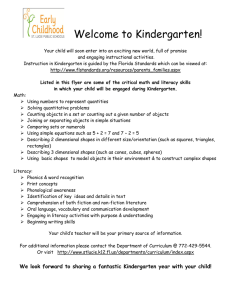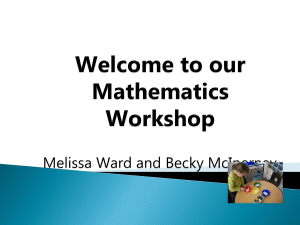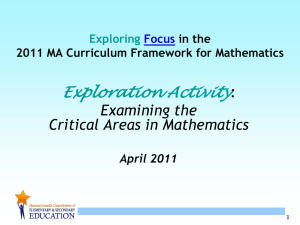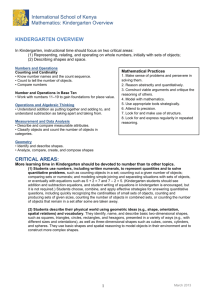Next Generation Standards and Objectives for Mathematics in West Virginia Schools
advertisement
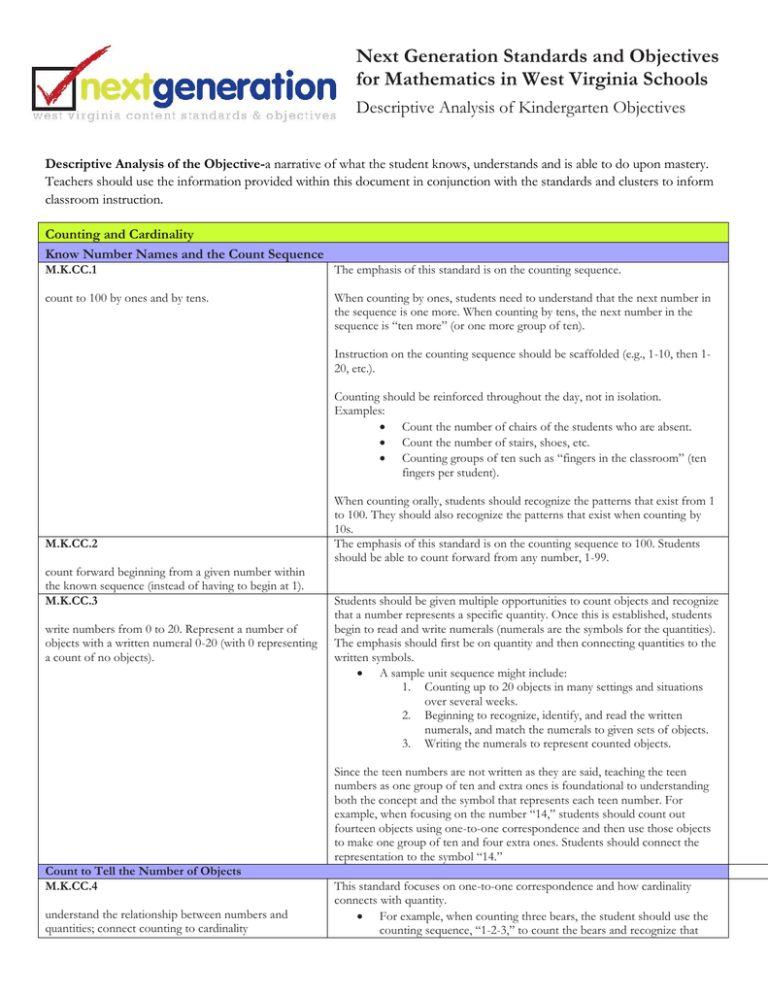
Next Generation Standards and Objectives for Mathematics in West Virginia Schools Descriptive Analysis of Kindergarten Objectives Descriptive Analysis of the Objective-a narrative of what the student knows, understands and is able to do upon mastery. Teachers should use the information provided within this document in conjunction with the standards and clusters to inform classroom instruction. Counting and Cardinality Know Number Names and the Count Sequence M.K.CC.1 The emphasis of this standard is on the counting sequence. count to 100 by ones and by tens. When counting by ones, students need to understand that the next number in the sequence is one more. When counting by tens, the next number in the sequence is “ten more” (or one more group of ten). Instruction on the counting sequence should be scaffolded (e.g., 1-10, then 120, etc.). Counting should be reinforced throughout the day, not in isolation. Examples: Count the number of chairs of the students who are absent. Count the number of stairs, shoes, etc. Counting groups of ten such as “fingers in the classroom” (ten fingers per student). M.K.CC.2 count forward beginning from a given number within the known sequence (instead of having to begin at 1). M.K.CC.3 write numbers from 0 to 20. Represent a number of objects with a written numeral 0-20 (with 0 representing a count of no objects). When counting orally, students should recognize the patterns that exist from 1 to 100. They should also recognize the patterns that exist when counting by 10s. The emphasis of this standard is on the counting sequence to 100. Students should be able to count forward from any number, 1-99. Students should be given multiple opportunities to count objects and recognize that a number represents a specific quantity. Once this is established, students begin to read and write numerals (numerals are the symbols for the quantities). The emphasis should first be on quantity and then connecting quantities to the written symbols. A sample unit sequence might include: 1. Counting up to 20 objects in many settings and situations over several weeks. 2. Beginning to recognize, identify, and read the written numerals, and match the numerals to given sets of objects. 3. Writing the numerals to represent counted objects. Since the teen numbers are not written as they are said, teaching the teen numbers as one group of ten and extra ones is foundational to understanding both the concept and the symbol that represents each teen number. For example, when focusing on the number “14,” students should count out fourteen objects using one-to-one correspondence and then use those objects to make one group of ten and four extra ones. Students should connect the representation to the symbol “14.” Count to Tell the Number of Objects M.K.CC.4 understand the relationship between numbers and quantities; connect counting to cardinality This standard focuses on one-to-one correspondence and how cardinality connects with quantity. For example, when counting three bears, the student should use the counting sequence, “1-2-3,” to count the bears and recognize that a. b. c. when counting objects, say the number names in the standard order, pairing each object with one and only one number name and each number name with one and only one object, understand that the last number name said tells the number of objects counted and the number of objects is the same regardless of their arrangement or the order in which they were counted, understand that each successive number name refers to a quantity that is one larger. M.K.CC.5 count to answer “how many?” questions about as many as 20 things arranged in a line, a rectangular array, a circle, or as many as 10 things in a scattered configuration; given a number from 1–20, count out that many objects. Compare Numbers M.K.CC.6 identify whether the number of objects in one group is greater than, less than, or equal to the number of objects in another group, e.g., by using matching and counting strategies. M.K.CC.7 “three” represents the group of bears, not just the third bear. A student may use an interactive whiteboard to count objects, cluster the objects, and state, “This is three”. In order to understand that each successive number name refers to a quantity that is one larger, students should have experience counting objects, placing one more object in the group at a time. For example, using cubes, the student should count the existing group, and then place another cube in the set. Some students may need to re-count from one, but the goal is that they would count on from the existing number of cubes. S/he should continue placing one more cube at a time and identify the total number in order to see that the counting sequence results in a quantity that is one larger each time one more cube is placed in the group. Students should develop counting strategies to help them organize the counting process to avoid re-counting or skipping objects. Examples: If items are placed in a circle, the student may mark or identify the starting object. If items are in a scattered configuration, the student may move the objects into an organized pattern. Some students may choose to use grouping strategies such as placing objects in twos, fives, or tens (note: this is not a kindergarten expectation). Counting up to 20 objects should be reinforced when collecting data to create charts and graphs. Students should develop a strong sense of the relationship between quantities and numerals before they begin comparing numbers. Other strategies: Matching: Students use one-to-one correspondence, repeatedly matching one object from one set with one object from the other set to determine which set has more objects. Counting: Students count the objects in each set, and then identify which set has more, less, or an equal number of objects. Observation: Students may use observation to compare two quantities (e.g., by looking at two sets of objects, they may be able to tell which set has more or less without counting). Observations in comparing two quantities can be accomplished through daily routines of collecting and organizing data in displays. Students create object graphs and pictographs using data relevant to their lives (e.g., favorite ice cream, eye color, pets, etc.). Graphs may be constructed by groups of students as well as by individual students. Benchmark Numbers: This would be the appropriate time to introduce the use of 0, 5 and 10 as benchmark numbers to help students further develop their sense of quantity as well as their ability to compare numbers. Students state whether the number of objects in a set is more, less, or equal to a set that has 0, 5, or 10 objects. Given two numerals, students should determine which is greater or less than the other. compare two numbers between 1 and 10 presented as written numerals. Operations and Algebraic Thinking Understand addition as putting together and adding to, and understand subtraction as taking apart and taking from. M.K.OA.1 Using addition and subtraction in a word problem context allows students to develop their understanding of what it means to add and subtract. represent addition and subtraction with objects, fingers, Students should use objects, fingers, mental images, drawing, sounds, acting out mental images, drawings, sounds (e.g., claps), acting out situations and verbal explanations in order to develop the concepts of addition situations, verbal explanations, expressions or equations. M.K.OA.2 solve addition and subtraction word problems and add and subtract within 10, e.g., by using objects or drawings to represent the problem. and subtraction. Then, they should be introduced to writing expressions and equations using appropriate terminology and symbols which include “+,” “–,” and “=”. Addition terminology: add, join, put together, plus, combine, total Subtraction terminology: minus, take away, separate, difference, compare Using a word problem context allows students to develop their understanding about what it means to add and subtract. Addition is putting together and adding to. Subtraction is taking apart and taking from. Kindergarteners develop the concept of addition/subtraction by modeling the actions in word problem using objects, fingers, mental images, drawings, sounds, acting out situations, and/or verbal explanations. Students may use different representations based on their experiences, preferences, etc. They may connect their conceptual representations of the situation using symbols, expressions, and/or equations. Students should experience the following addition and subtraction problem types (see Table 1). M.K.OA.3 decompose numbers less than or equal to 10 into pairs in more than one way, e.g., by using objects or drawings, and record each decomposition by a drawing or equation (e.g., 5 = 2 + 3 and 5 = 4 + 1). Add To word problems, such as, “Rachel had 3 apples. Her friend gave her 2 more. How many does she have now?” o A student’s “think aloud” of this problem might be, “I know that Mia has some apples and she’s getting some more. So she’s going to end up with more apples than she started with.” Take From problems such as: o Brody had 8 markers and he gave 2 away. How many does he have now? When modeled, a student would begin with 8 objects and remove two to get the result. Put Together/Take Apart problems with Total Unknown gives students opportunities to work with addition in another context such as: o There are 2 red apples on the counter and 3 green apples on the counter. How many apples are on the counter? Solving Put Together/Take Apart problems with Both Addends Unknown provides students with experiences with finding all the decompositions of a number and investigating the patterns involved. o There are 10 apples on the counter. Some are red and some are green. How many apples could be green? How many apples could be red? This standard focuses on number pairs which add to a specified total, 1-10. These number pairs may be examined either in or out of context. Students may use objects such as cubes, two-color counters, square tiles, etc. to show different number pairs for a given number. For example, for the number 5, students may split a set of 5 objects into 1 and 4, 2 and 3, etc. Students may also use drawings to show different number pairs for a given number. For example, students may draw 5 objects, showing how to decompose in several ways. Sample unit sequence: A contextual problem (word problem) is presented to the students such as, “Lindsey goes to Abby’s house. Abby tells her she may have 5 pieces of fruit to take home. There are lots of apples and bananas. How many of each can she take?” Students find related number pairs using objects (such as cubes or two-color counters), drawings, and/or equations. Students may use different representations based on their experiences, preferences, etc. M.K.OA.4 for any number from 1 to 9, find the number that makes 10 when added to the given number, e.g., by using objects or drawings, and record the answer with a drawing or equation. Students may write equations that equal 5 such as: o 5=4+1 o 3+2=5 o 2+3=4+1 This is a good opportunity for students to systematically list all the possible number pairs for a given number. For example, all the number pairs for 5 could be listed as 0+5, 1+4, 2+3, 3+2, 4+1, and 5+0. Students should describe the pattern that they see in the addends, e.g., each number is one less or one than the previous addend. The number pairs that total ten are foundational for students’ ability to work fluently within base-ten numbers and operations. Different models, such as ten-frames, cubes, two-color counters, etc., assist students in visualizing these number pairs for ten. Example 1: Students place three objects on a ten frame and then determine how many more are needed to “make a ten.” Students may use electronic versions of ten frames to develop this skill. Example 2: The student snaps ten cubes together to make a “train.” Student breaks the “train” into two parts. S/he counts how many are in each part and record the associated equation (10 = ___ + ___). Student breaks the “train into two parts. S/he counts how many are in one part and determines how many are in the other part without directly counting that part. Then s/he records the associated equation (if the counted part has 4 cubes, the equation would be 10 = 4 + ___). Student covers up part of the train, without counting the covered part. S/he counts the cubes that are showing and determines how many are covered up. Then s/he records the associated equation (if the counted part has 7 cubes, the equation would be 10 = 7 + ___). M.K.OA.5 fluently add and subtract within 5. Example 3: The student tosses ten two-color counters on the table and records how many of each color are facing up. This standard focuses on students being able to add and subtract numbers within 5. Adding and subtracting fluently refers to knowledge of procedures, knowledge of when and how to use them appropriately, and skill in performing them flexibly, accurately, and efficiently. Strategies students may use to attain fluency include: Counting on (e.g., for 3+2, students will state, “3,” and then count on two more, “4, 5,” and state the solution is “5”) Counting back (e.g., for 4-3, students will state, “4,” and then count back three, “3, 2, 1” and state the solution is “1”) Counting up to subtract (e.g., for 5-3, students will say, “3,” and then count up until they get to 5, keeping track of how many they counted up, stating that the solution is “2”) Using doubles (e.g., for 2+3, students may say, “I know that 2+2 is 4, and 1 more is 5”) Using commutative property (e.g., students may say, “I know that 2+1=3, so 1+2=3”) Using fact families (e.g., students may say, “I know that 2+3=5, so 53=2”) Number and Operation in Base Ten Work with Numbers 11-19 to Gain Foundation for Place Value M.K.NBT.1 Special attention needs to be paid to this set of numbers as they do not follow a consistent pattern in the verbal counting sequence. compose and decompose numbers from 11 to 19 into Eleven and twelve are special number words. ten ones and some further ones, e.g., by using objects or “Teen” means one “ten” plus ones. drawings, and record each composition or The verbal counting sequence for teen numbers is backwards – we say decomposition by a drawing or equation, e.g., 18 = 10 + the ones digit before the tens digit. For example “27” reads tens to 8; understand that these numbers are composed of ten ones (twenty-seven), but 17 reads ones to tens (seven-teen). ones and one, two, three, four, five, six, seven, eight, or In order for students to interpret the meaning of written teen nine ones. numbers, they should read the number as well as describe the quantity. For example, for 15, the students should read “fifteen” and state that it is one group of ten and five ones and record that 15 = 10 + 5. Teaching the teen numbers as one group of ten and extra ones is foundational to understanding both the concept and the symbol that represent each teen number. For example, when focusing on the number “14,” students should count out fourteen objects using one-to-one correspondence and then use those objects to make one group of ten ones and four additional ones. Students should connect the representation to the symbol “14.” Students should recognize the pattern that exists in the teen numbers; every teen number is written with a 1 (representing one ten) and ends with the digit that is first stated. Measurement and Data Describe and Compare Measurable Attributes M.K.MD.1 describe measurable attributes of objects, such as length or weight and describe several measurable attributes of a single object. M.K.MD.2 directly compare two objects with a measurable attribute in common, to see which object has “more of”/“less of” the attribute, and describe the difference. For example, directly compare the heights of two children and describe one child as taller/shorter. In order to describe attributes such as length and weight, students must have many opportunities to informally explore these attributes. Students should compare objects verbally and then focus on specific attributes when making verbal comparisons for K.MD.2. They may identify measurable attributes such as length, width, height, and weight. For example, when describing a soda can, a student may talk about how tall, how wide, how heavy, or how much liquid can fit inside. These are all measurable attributes. Non-measurable attributes include: words on the object, colors, pictures, etc. When making direct comparisons for length, students must attend to the “starting point” of each object. For example, the ends need to be lined up at the same point, or students need to compensate when the starting points are not lined up (conservation of length includes understanding that if an object is moved, its length does not change; an important concept when comparing the lengths of two objects). Language plays an important role in this standard as students describe the similarities and differences of measurable attributes of objects (e.g., shorter than, taller than, lighter than, the same as, etc.). Classify Objects and Count the Number of Objects in Each Category M.K.MD.3 Possible objects to sort include buttons, shells, shapes, beans, etc. After sorting and counting, it is important for students to: classify objects into given categories, count the numbers explain how they sorted the objects; of objects in each category, and sort the categories by label each set with a category; count. Category counts should be limited to less than or answer a variety of counting questions that ask, “How many …”; equal to 10. compare sorted groups using words such as, “most”, “least”, “alike” and “different”. Geometry Identify and Describe Shapes (squares, circles, triangles, rectangles, hexagons, cubes, cones, cylinders and spheres) M.K.G.1 Examples of environments in which students would be encouraged to identify shapes would include nature, buildings, and the classroom using positional describe objects in the environment using names of words in their descriptions. shapes and describe the relative positions of these objects using terms such as above, below, beside, in front of, behind and next to. Teachers should work with children and pose four mathematical questions: Which way? How far? Where? And what objects? To answer these questions, children develop a variety of important skills contributing to their spatial thinking. Examples: Teacher holds up an object such as an ice cream cone, a number cube, ball, etc. and asks students to identify the shape. Teacher holds up a can of soup and asks,” What shape is this can?” Students respond “cylinder!” Teacher places an object next to, behind, above, below, beside, or in front of another object and asks positional questions. Where is the water bottle? (water bottle is placed behind a book) Students say “The water bottle is behind the book.” M.K.G.2 correctly name shapes regardless of their orientations or overall size. Students should have multiple opportunities to identify shapes; these may be displayed as photographs, or pictures using the document camera or interactive whiteboard. Students should be exposed to many types of triangles in many different orientations in order to eliminate the misconception that a triangle is always right-side-up and equilateral. Students should also be exposed to many shapes in many different sizes. M.K.G.3 identify shapes as two-dimensional (lying in a plane, “flat”) or three-dimensional (“solid”). Analyze, Compare, Create and Compose Shapes M.K.G.4 analyze and compare two- and three-dimensional shapes, in different sizes and orientations, using informal language to describe their similarities, differences, parts (e.g., number of sides and vertices/“corners”) and other attributes (e.g., having sides of equal length). M.K.G.5 model shapes in the world by building shapes from components (e.g., sticks and clay balls) and drawing shapes. Examples: Teacher makes pairs of paper shapes that are different sizes. Each student is given one shape and the objective is to find the partner who has the same shape. Teacher brings in a variety of spheres (tennis ball, basketball, globe, ping pong ball, etc) to demonstrate that size doesn’t change the name of a shape. Student should be able to differentiate between two dimensional and three dimensional shapes. Student names a picture of a shape as two dimensional because it is flat and can be measured in only two ways (length and width). Student names an object as three dimensional because it is not flat (it is a solid object/shape) and can be measured in three different ways (length, width, height/depth). Students analyze and compare two- and three-dimensional shapes by observations. Their visual thinking enables them to determine if things are alike or different based on the appearance of the shape. Students sort objects based on appearance. Even in early explorations of geometric properties, they are introduced to how categories of shapes are subsumed within other categories. For instance, they will recognize that a square is a special type of rectangle. Students should be exposed to triangles, rectangles, and hexagons whose sides are not all congruent. They first begin to describe these shapes using everyday language and then refine their vocabulary to include sides and vertices/corners. Opportunities to work with pictorial representations, concrete objects, as well as technology helps student develop their understanding and descriptive vocabulary for both two- and three- dimensional shapes. Because two-dimensional shapes are flat and three-dimensional shapes are solid, students should draw two-dimensional shapes and build threedimensional shapes. Shapes may be built using materials such as clay, toothpicks, marshmallows, gumdrops, straws, etc. M.K.G.6 compose simple shapes to form larger shapes. For example, “Can you join these two triangles with full sides touching to make a rectangle?” Students use pattern blocks, tiles, or paper shapes and technology to make new two- and three-dimensional shapes. Their investigations allow them to determine what kinds of shapes they can join to create new shapes. They answer questions such as “What shapes can you use to make a square, rectangle, circle, triangle? …etc.” Students may use a document camera to display shapes they have composed from other shapes. They may also use an interactive whiteboard to copy shapes and compose new shapes. They should describe and name the new shape. Table 1 Result Unknown Add to Three kittens sat in the basket. Two more kittens ran there. How many kittens are in the basket now? 3+2=? Change Unknown Three kittens were sitting in the basket. Some more kittens ran there. Then there were five kittens. How many kittens ran over to the first three? Start Unknown Some kittens were sitting in the basket. Two more kittens ran there. Then there were five kittens. How many kittens were in the basket before? ?+2=5 3+?=5 Take from Five crackers were on the table. I ate three crackers. How many crackers are on the table now? 5–3=? Total Unknown Put Together / Take Apart1 Five crackers were on the table. I ate some crackers. Then there were two crackers. How many crackers did I eat? Some crackers were on the table. I ate three crackers. Then there were two crackers. How many crackers were on the table before? 5–?=2 ?–3=2 Addend Unknown Both Addends Unknown1 Three brown horses and two white horses are in the barn. How many horses are in the barn? Five horses are in the barn. Three are brown, and the rest are white. How many horses are white? Mom has five kinds of flowers. How many can she plant in the round flower bed, and how many can she plant in the square flower bed? 3+2=? 3 + ? = 5, 5 – 3 = ? 5 = 0 + 5, 5 = 5 + 0 5 = 1 + 4, 5 = 4 + 1 5 = 2 + 3, 5 = 3 + 2 Difference Unknown Bigger Unknown Smaller Unknown (“How many more?” version): (Version with “more”): (Version with “more”): Allison has three pencils. Denise has five pencils. How many more pencils does Denise have than Allison? Denise has three more pencils than Allison. Allison has two pencils. How many pencils does Denise have? Denise has three more pencils than Allison. Denise has five pencils. How many pencils does Allison have? (Version with “fewer”): Compare2 (“How many fewer?” version): (Version with “fewer”): Allison has two pencils. Denise has five pencils. How many fewer pencils does Allison have than Denise? Allison has 3 fewer pencils than Denise. Allison has two pencils. How many pencils does Denise have? 3 + ? = 5, 5 – 2 = ? 2 + 3 = ?, 3 + 2 = ? Allison has 3 fewer pencils than Denise. Denise has five pencils. How many pencils does Allison have? 5 – 3 = ?, ? + 3 = 5 1Either addend can be unknown, so there are three variations of these problem situations. Both Addends Unknown is a productive extension of this basic situation, especially for small numbers less than or equal to 10. 2For the Bigger Unknown or Smaller Unknown situations, one version directs the correct operation (the version using more for the bigger unknown and using less for the smaller unknown). The other versions are more difficult.


